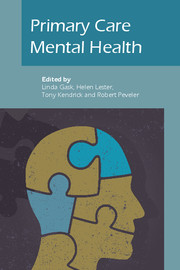Book contents
- Frontmatter
- Contents
- List of figures, tables and boxes
- List of contributors
- Preface
- Part I Conceptual basis and overarching themes
- Part II Clinical issues
- 8 Depression
- 9 Suicide and self-harm
- 10 Anxiety
- 11 Medically unexplained symptoms
- 12 Mental health problems in older people
- 13 Perinatal mental health
- 14 Child and adolescent mental health
- 15 Psychosis
- 16 Emergencies in primary care
- 17 Substance misuse
- 18 Management of alcohol problems
- 19 Eating disorders
- 20 Physical health of people with mental illness
- 21 Ethnic minorities
- 22 Asylum seekers and refugees
- 23 Sexual problems
- Part III Policy and practice
- Part IV Reflective practice
- Epilogue: Racing pigeons and rolling rocks: reflections on complex problems in primary care
- Index
19 - Eating disorders
from Part II - Clinical issues
Published online by Cambridge University Press: 02 January 2018
- Frontmatter
- Contents
- List of figures, tables and boxes
- List of contributors
- Preface
- Part I Conceptual basis and overarching themes
- Part II Clinical issues
- 8 Depression
- 9 Suicide and self-harm
- 10 Anxiety
- 11 Medically unexplained symptoms
- 12 Mental health problems in older people
- 13 Perinatal mental health
- 14 Child and adolescent mental health
- 15 Psychosis
- 16 Emergencies in primary care
- 17 Substance misuse
- 18 Management of alcohol problems
- 19 Eating disorders
- 20 Physical health of people with mental illness
- 21 Ethnic minorities
- 22 Asylum seekers and refugees
- 23 Sexual problems
- Part III Policy and practice
- Part IV Reflective practice
- Epilogue: Racing pigeons and rolling rocks: reflections on complex problems in primary care
- Index
Summary
Eating disorders are common and are associated with high rates of morbidity and mortality. However, sufferers are often ambivalent about seeking treatment. On average, they present only after several years and they commonly present with non-specific physical and psychological symptoms, which may not initially be attributed to the eating disorder. They are therefore under-recognised and often go untreated (Hoek, 1993). Furthermore, once they are diagnosed, many health professionals feel illequipped to manage them and the availability of specialist provision is very variable (Royal College of Psychiatrists, 2000). Mild cases may, though, be managed in primary care.
Definitions
An eating disorder is a disturbance of eating habits or weight control behaviour that results in significant impairment of physical health or psychosocial functioning (which is not secondary to a medical condition or other psychiatric disorder). The two major categories are anorexia nervosa and bulimia nervosa (Box 19.1) but most eating disorders (more than half) do not satisfy criteria for these full syndromes (Fairburn & Harrison, 2003). Hence ICD–10 (World Health Organization, 1992) recognises partial syndromes of atypical anorexia nervosa and atypical bulimia nervosa as well as a number of minor categories: overeating associated with other psychological disturbances (excludes simple obesity); vomiting associated with other psychological disturbances; other eating disorders (including pica in adults and psychogenic loss of appetite); and eating disorder, unspecified. DSM–IV (American Psychiatric Association, 1994) also includes the category of ‘eating disorder not otherwise specified’ (EDNOS) and a further provisional category of binge eating disorder (where there is recurrent binge eating without the use of compensatory strategies such as purging).
Epidemiology
The prevalence of anorexia nervosa in young females is of the order of 0.3%, that of bulimia nervosa around 1%, and that of EDNOS around 1–3% (Hoek et al, 2003). Eating disorders are much more common in females than in males (anorexia nervosa 12:1, bulimia nervosa 6:1, and binge eating disorder 4:1) (Fichter & Krenn, 2003). General practitioners (GPs) with a list of 2000 patients will have around 3 patients with anorexia nervosa and 11 patients with bulimia nervosa on their list (Hoek, 1993). In addition to this, they will be likely to have a further 15 or so with EDNOS.
- Type
- Chapter
- Information
- Primary Care Mental Health , pp. 283 - 295Publisher: Royal College of PsychiatristsPrint publication year: 2009

